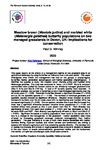Meadow brown (Maniola jurtina) and marbled white (Melanargia galathea) butterfly populations on two managed grasslands in Devon, UK: Implications for conservation
| dc.contributor.author | Winney, P.G. | |
| dc.date.accessioned | 2019-05-13T10:09:29Z | |
| dc.date.available | 2019-05-13T10:09:29Z | |
| dc.date.issued | 2009 | |
| dc.identifier.citation |
Winney, P.G. (2009) 'Meadow brown (Maniola jurtina) and marbled white (Melanargia galathea) butterfly populations on two managed grasslands in Devon, UK: Implications for conservation', The Plymouth Student Scientist, p. 50-68. | en_US |
| dc.identifier.issn | 1754-2383 | |
| dc.identifier.uri | http://hdl.handle.net/10026.1/13853 | |
| dc.description.abstract |
This paper reports on the effects of a management regime on two grassland sites in an agricultural landscape by using butterflies as indicators over a six-year period. This paper investigates what effects the management has had on two groups of phytophagous butterflies; habitat generalists (polyphagous) and habitat specialists (oligophagous). It identifies two species to study, the meadow brown Maniola jurtina and marbled white Melanargia galathea. The study was conducted in Devon, UK in 2007. Butterfly and plant communities were studied by transect counts on two differently managed grassland sites (Site A: 8 ha and Site B: 4.04 ha). A total of 27 butterfly species were recorded. In regression analysis, the number of butterflies at site A had increased significantly over the six study years (P < 0.05). Generalist butterflies showed a significant increase (P < 0.05) and so did the specialist species (P = < 0.05). The numbers of individual generalist and specialist species showed no significant difference. Meadow brown showed an erratic increase in numbers over the six study years with no significance and marbled white has increased significantly (P < 0.05). The comparison between Site A and Site B showed that there was a significant difference between meadow brown populations (P < 0.05) and marbled whites were present at Site A and absent from Site B. Plant diversity was significantly different from each year studied (P < 0.001) and had decreased at Site A between 2002 and 2007. Plant diversity was significantly different at Site A and Site B (P < 0.001). Significant increases of butterfly populations were found at the sample site A due to a change in the management of the grassland. Habitat specialists were more affected by increasing grassland coverage (reduced heterogeneity) than habitat generalists. The goal therefore is to see a much more diverse landscape with habitat corridors linking important habitats and where farmers and landowners are striking a balance with intensive agriculture and thus conserving species diversity. The development of studies into the long-term effects of rough grassland sites on butterfly diversity is needed in the near future, to enable conservationists, government bodies and the landowners themselves to implement a landscape scale conservation scheme. | en_US |
| dc.language.iso | en | en_US |
| dc.publisher | University of Plymouth | |
| dc.rights | Attribution 3.0 United States | * |
| dc.rights.uri | http://creativecommons.org/licenses/by/3.0/us/ | * |
| dc.subject | Butterflies | en_US |
| dc.subject | Grassland | en_US |
| dc.subject | Generalist | en_US |
| dc.subject | Specialist | en_US |
| dc.subject | Habitat conservation | en_US |
| dc.title | Meadow brown (Maniola jurtina) and marbled white (Melanargia galathea) butterfly populations on two managed grasslands in Devon, UK: Implications for conservation | en_US |
| dc.type | Article | |
| plymouth.issue | 1 | |
| plymouth.volume | 2 | |
| plymouth.journal | The Plymouth Student Scientist |



